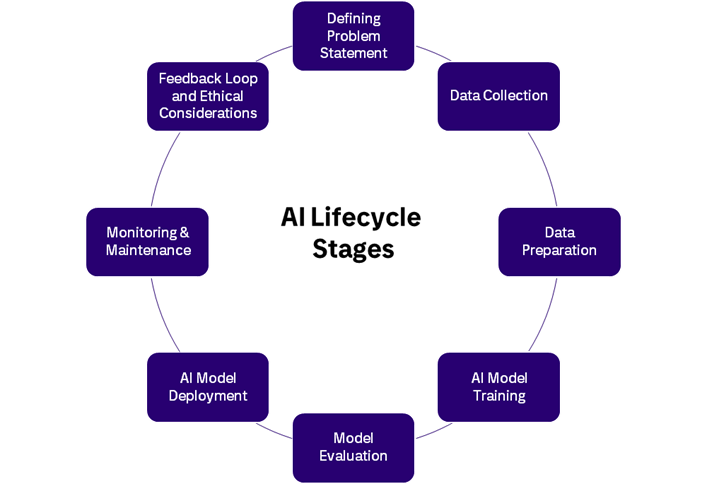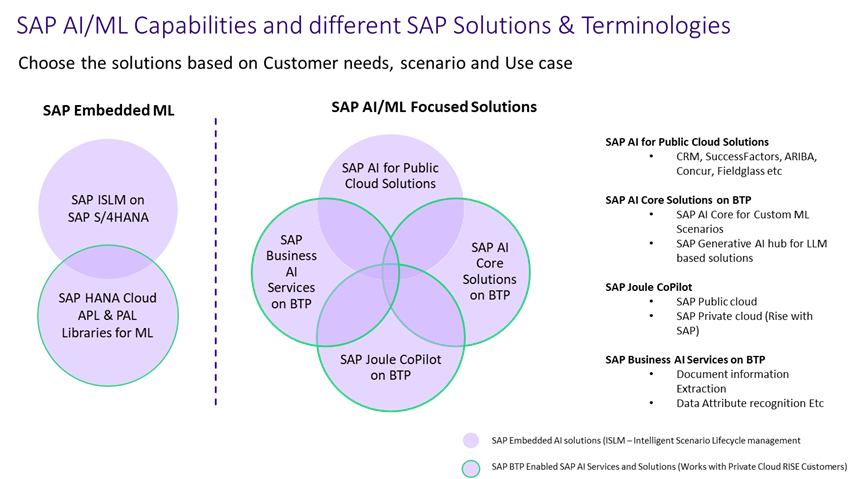
AI in SAP: Why your data strategy will make or break your success
The AI landscape is evolving rapidly, but its success fundamentally depends on data—its availability, quality, and accuracy.
Join the SAP GO CommunityIf there’s one fact every AI expert agrees on, it’s that AI is only as smart as the data that fuels it. In an era where enterprises are racing to implement AI and machine learning (ML) within their SAP environments, success hinges on a single factor: the quality and management of their data.
Before embarking on AI-driven transformation, enterprises must establish robust data management and AI governance frameworks. In this blog, we explore why data isn’t just a supporting player in AI adoption—it’s the driving force behind every intelligent business innovatio
AI and data – a synergistic approach
An intelligent enterprise must become data-driven to extract valuable insights and support decision-making across business functions. AI technologies, including predictive, prescriptive, and generative AI, rely heavily on data throughout their lifecycle, from raw data collection to model deployment.
A typical AI lifecycle involves the following stages, where data plays a crucial role in delivering accurate and meaningful outputs:
AI lifecycle stages (with examples based on an actual use case)

- Defining the problem statement
First, organizations must identify the type of data required to address specific business challenges. This involves assessing existing datasets, pinpointing gaps, and aligning data strategy with business objectives.
Use case: One of our key manufacturing customers wanted real-time “Finished product defect prediction” capabilities in their manufacturing setup. The data for this scenario consists of numeric sensor data, unstructured defect descriptions data, historical defect data along with correlation of the sensor data for the defect predictions.
- Data collection
Gathering structured and unstructured data from multiple sources—including sensor readings, system logs, text descriptions and transactional records—is essential. A well-rounded dataset helps AI models capture real-world variables influencing outcomes.
Use case: Our manufacturing customer’s data for defect description was available in the quality systems along with SAP and Non-SAP sources, and the sensor data was stored in their big data IoT data store. The correlation between sensor data and quality defects needed to be established, and this data resided outside the SAP System. We finalized the data collection and storage strategies together with our customer.
- Data preparation
Raw data must be refined through cleaning, normalization, and transformation. It is necessary to remove duplicates, handle missing values, and address data inconsistencies before employing the data for AI purposes. This stage also involves feature engineering, where relevant variables are derived from raw inputs to enhance model performance.
Use case: We prepared our customer’s correlated sensor and defective product data. Additionally, we gathered product variations and defect descriptions. We also identified and deleted outliers and eliminated incomplete, partial data without values. This data preparation and transformation was carried out using SAP HANA Cloud and data was stored in AWS S3. SAP AI Launchpad was then connected to AWS S3 to retrieve data during the execution.
- Training AI models
AI models learn from historical data, which makes data quality crucial. Various learning methods—supervised, unsupervised, and reinforcement learning—depend on structured and labeled datasets to recognize patterns and improve predictive accuracy.
To train AI models, we use processed data to optimize model parameters and validate the model on unseen subsets. A typical AI model training will go through the following learning cycles, in which data is always at the core.
- Foundation for learning: AI models are trained on data to recognize patterns, make decisions, and predict outcomes.
- Supervised learning: Models learn from labeled datasets (e.g., defect images labeled as "good" or "defective").
- Unsupervised learning: Models identify patterns in unlabeled data (e.g., clustering sensor data for anomaly detection).
- Reinforcement learning: Models learn through feedback by interacting with an environment and improving based on results.
Use case: Once our manufacturing customer’s data was available, we carried out analyses using multiple models such as classification models for prediction of the defect categories, regression models for severity, and anomaly detection models for each cycle that we had to prepare (and for which we had to transform data to make it suitable for model training). We used SAP AI Core on SAP AI Launchpad in SAP BTP for enabling the model trainings.
- Model evaluation
The effectiveness of an AI model is assessed by testing it against new data. Metrics such as precision, recall, and accuracy determine its real-world applicability. The quality, diversity, and volume of test data significantly impact performance outcomes.
Use case: As the next step, we compared several model executions against the scenario in SAP AI Launchpad to assess accuracy. We conducted multiple training cycles with varying volumes of data, and utilized five thousand unique records. This gave us insights into the model performance and accuracy.
-
Deployment
For AI models to deliver business value, they must be seamlessly integrated with data pipelines and operational workflows. Deployment strategies must ensure real-time or batch data processing for reliable decision-making.Use case: Based on the model performance comparison that we carried out, we deployed the trained model in SAP AI Core for our manufacturing customer. The API link generated through the deployment was then integrated in a Custom Fiori application for consumption. From an architecture point of view, the IoT sensor data was directly pushed into the Fiori UI and subsequently to the trained model for defect classification prediction.
- Monitoring and maintenance
AI models require continuous oversight to detect shifts in data patterns. Periodic retraining using updated datasets ensures models remain relevant in dynamic business environments. SAP AI Launchpad provides us with the capability to set up the necessary batch jobs for the continuous training executions. - Feedback loop & ethical considerations
User feedback and system performance analytics inform model refinement. Adhering to data governance principles, privacy regulations, and ethical AI practices helps maintain transparency and trust.
Use case: To provide readers another use case example in addition to the defect prediction case discussed so far: we are currently exploring building a Generative AI solution for supplier evaluation. This involves developing an AI model that can access sensitive employee data, personal information relating to suppliers, as well as supplier performance data, which need to be protected from unwanted access.
SAP Tools and Platforms
SAP provides a comprehensive suite of solutions to manage enterprise data and AI lifecycles efficiently. Some key offerings include:
- SAP HANA Cloud: An in-memory database optimized for high-speed analytics and machine learning workloads.
- SAP Business Technology Platform (BTP): The backbone for SAP’s AI and ML services, encompassing tools like SAP Business AI, SAP AI Launchpad, SAP Generative AI Hub, and embedded AI frameworks for predictive modeling.

- SAP Analytics Cloud: A business intelligence solution that enables data-driven decision-making with built-in AI/ML capabilities.
- SAP Datasphere: A scalable solution for integrating, analyzing, and managing enterprise data across multiple sources.
- SAP Data Intelligence: A platform for data integration, governance, and orchestration, designed to support AI and ML-driven insights. (Planned to sunset by 2028, functionality migrated to SAP Datasphere)
- SAP IoT Services: Designed to handle real-time sensor data, enabling AI applications for predictive maintenance and process optimization.
By leveraging these solutions, enterprises can build robust AI-driven ecosystems that support automation, advanced analytics, and innovation at scale.
Key characteristics of data & AI management platforms
To enable a strong AI and data strategy, organizations should focus on platforms with the following characteristics:
- Scalability – Ability to handle large volumes of structured and unstructured data while adapting to growing business needs.
- Compliance & security – Adherence to frameworks like GDPR and HIPAA to protect sensitive business and customer information.
- Real-time processing – Low-latency data processing enables timely decision-making in critical operations.
- Integration & interoperability – Seamless data connectivity across CRM, ERP, and other enterprise applications ensures comprehensive AI model training.
- Data consistency & accuracy – Ensuring data is clean, accurate, and standardized improves AI reliability and performance.
- End-to-end AI model management – Platforms should support data preprocessing, model training, validation, and deployment within a single framework.
- Advanced analytics & insights – Predictive and prescriptive analytics help organizations derive deeper business value.
- Cost efficiency & automation – Cloud-based solutions optimize resources while reducing manual data processing efforts.
- Continuous innovation – AI-powered platforms must evolve with emerging trends, ensuring businesses stay competitive.
Conclusion
Without a solid data foundation, even the most advanced AI models will struggle to deliver real business impact. For organizations aiming to become data-driven, understanding the role of data in AI adoption is an absolute must.
AI solutions require structured and unstructured data to operate effectively, making enterprise-grade data management platforms essential for success. To successfully transform with AI, businesses must assess their AI strategies, data readiness, and SAP solution landscape, ensuring alignment with SAP’s AI roadmap.
SAP GO Community
Join now to stay updated with the latest SAP news and insights




